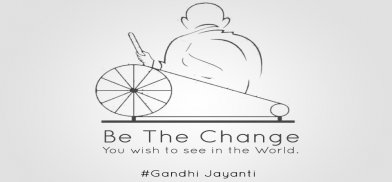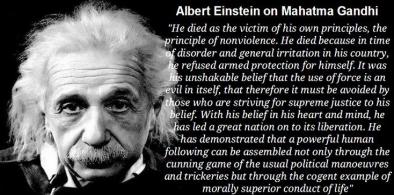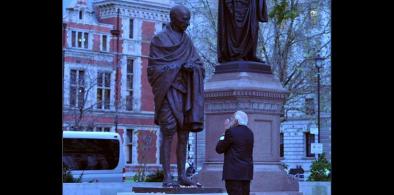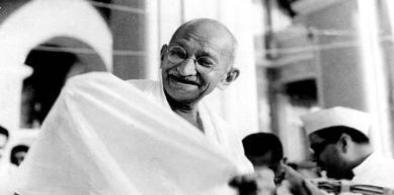Mantra of development should be spirituality with high technology – the Gandhian way
Gandhi believed in all-inclusive growth and felt that India can only become a great nation when its teeming and impoverished rural masses become better off, writes Anil K. Rajvanshi for South Asia Monitor

Mahatma Gandhi, whose 152nd birth anniversary is being celebrated on October 2, not only gave India her freedom but also gave the world a new thought on nonviolence and sustainable living. His teachings and experiments are more valid today, than ever before, especially when mankind is trying to find solutions to worldwide greed, unsustainable living, racial and religious violence; all of which are putting a heavy burden on the world’s resources.
Through the ages India has time and again given to the world a new thought. Thus Buddhism, Jainism, Yogic system, Sikhism are all part of the great spiritual thoughts given by India from time to time. Gandhiji’s message of nonviolence and sustainable living is a continuation of that long tradition.
One may say Gandhiji’s greatest contribution to sustainable development was two-fold. First are his experiments in simple living and high thinking. He believed that with simple living the resources of the planet earth can sustain human beings comfortably and his famous saying that earth provides us enough for our needs but not for our greed is extremely apt today.
Second is his insistence on all-inclusive growth of the society and hence he focused on uplifting the bottom of the pyramid population. Both these issues are as relevant today as they were 100 years ago when Gandhiji enumerated them.
Gandhi’s spirituality
Gandhiji was a highly evolved and spiritual human being. To him spirituality came first. Other things like politics, public life etc. were by-products of his spirituality. Also as a person progresses on the path of spirituality, his or her priorities in life change. The focus of life shifts more towards getting personal happiness through mental peace or by helping others and less on material needs, greed and desires. Gandhiji’s experiments on simple and sustainable living followed his spiritual progress.
He also realized from an early age the importance of a great body and mind. In this he was following the tenets of the ancient yogic system which stresses on a healthy body and a powerful mind. Thus all his experiments on food, brahmacharya (celibacy) and fasting came from this belief.
Besides, he also realized that to fight a powerful enemy like Britain, he had to make his body-temple extremely powerful so that it could sustain long fights. This meant that it had to need the least amount of comforts and external inputs and thus Gandhiji showed that with simple living he could produce the highest quality of thought. This was an ultimate example of sustainable living.
The spirit of the Bhagvad Gita’s Karma Yoga guided him in his endeavors, and he considered it as his duty to help his countrymen and fellow beings. There are many instances of people who saw his glowing skin, aura, and felt the presence of his personality whenever they met him. That is only possible for a yogi of very high order.
Possessed with a great body and a powerful mind he also became fearless, and it is this quality of fearlessness that made him blaze new trails and produce novel political strategies like nonviolence, Satyagraha, etc. Time and again he showed his fearlessness by dealing with the British on equal terms. In the 1920s and 30s during the height of colonial rule such a behavior of a subject in front of his colonial masters was unique and provided a quantum jump in raising the consciousness of Indians.
When the brain becomes very powerful it also becomes sensitive to its surroundings. This is the genesis of nonviolence as this makes all life sacred. Mahatma Gandhi was a prime example of this principle.
Gandhiji as the high priest of nonviolence used it for everything including industrialization. He rightly thought the industrialization of the 1920s to be a violent system with heavy machinery, very inefficient energy and materials conversion technologies with no concern for the environment. Intuitively he revolted against those systems and felt that simple life (with few needs) and most of the daily things to be produced from locally available materials was nonviolent and in tune with nature.
Decentralized rural development
Gandhi was not anti-technology or science. He was a prisoner of his times. He always said that he was a "pujari" (priest) of “body-temple” and since it was the most complex machinery in the world, how could he be anti-machinery! He believed in rural-based and economically viable local production and consumption systems. Hence, he was against things made in Bombay (now Mumbai) and shipped to rural areas.
Similarly, he objected to electricity being produced in Bombay and transmitted to Wardha (where his ashram was in the western Indian state Maharashtra). He wanted it produced in Wardha from local resources – again showing his vision since decentralized power production is gaining currency.
Not being a student of science or engineering he could not express his feelings in a scientific way, but always talked about his dream village which he felt will be self-sufficient with its inhabitants living in harmony with nature. It seems Gandhi was an engineer at heart. Modern technology which is following bio-mimicry allows for the first time to have softer and efficient systems to achieve human purposes and for the Gandhian dream to become a reality.
If the Mahatma were alive today, he would have felt that his dream village could have taken shape with the availability of internet connectivity, desktop manufacturing and small renewable energy power packs. His dream of giving employment and decent life to the rural population may become possible with the availability of these energy-efficient and high-tech systems.
As a spiritual being and a visionary, Gandhiji was far ahead of his times. For example he was energy conservator par excellence. He lived in his ashrams without electricity or any modern amenities. His insistence on the use of self/human labor for the majority of needs was legendary and was usually frowned upon by his closest colleagues who thought it was anti-progress and pushing back India to stone ages.
Nevertheless with the recent development of sophisticated man-machine interface technologies like free play radios, human-powered electricity producing units for laptops, cell phones, etc, the use of self/human labor maybe able to solve the twin problems of obesity and energy!
Gandhi believed in all-inclusive growth and felt that India can only become a great nation when its teeming and impoverished rural masses become better off. He, therefore, focused on rural development for the last 30 years of his life and felt intuitively that the future of India is in decentralized rural development. This vision which he stated in the 1920’s is even more valid today after almost 100 years.
For this to happen, creation of wealth and employment should take place in rural areas. This is possible when agriculture provides both energy and food security for India in an economically viable manner. It is the land that provides the wealth of the country - a message that Gandhi always gave regarding rural development.
This strategy requires strengthening the farmers and the farming sector. The present farming laws may not somehow do so. Suffice it to say that when the farmers are neglected, the long-term sustainability of the country is threatened. When farms produce both food and fuel then their utility becomes manifold.
In India, 65 percent of the population depends on farming, and with energy from agriculture as a major focus, India has the potential of becoming a high-tech farming community. This will help improve the rural environment and create better India, something that Gandhiji always stressed.
One strongly believes this can be done through the use of high technology for rural applications. High technology allows the conversion of abundant locally available 'dilute' energy resources like biomass, solar, wind etc. into useful end-products and services. Together with modern methods of production and distribution they can also be economically feasible. In this process one needs to follow nature and so the mantra of technology development should be biomimicry.
Natural systems through millions of years have evolved into very efficient materials and energy converters. In this process, size of the system reduces and its efficiency and complexity increase. Some of the designs and technologies are following this strategy. For example, computer chips, cell phones, power plants, etc. are all becoming very efficient, small in size, complex and economically viable. Technology developers should follow this strategy in developing rural technologies.
Lessons for future
Every citizen of this earth aspires to a decent lifestyle. Such a lifestyle is possible with much less energy than is consumed by an average US citizen. For example, in the US the per capita energy consumption is ~300 GJ/yr, whereas in India it is a low of 18 GJ/yr. If every citizen of India has the consumptive lifestyle of Americans, then all the resources of earth will only be sufficient for India alone.
I feel energy consumption of 50-70 GJ/person/yr or one-fifth that of the US can provide a decent and emotionally satisfying lifestyle. This energy consumption will give the lifestyle that Europeans had in the 1970s. This type of energy consumption will put much less pressure on the earth’s resources besides reducing substantially the environmental pollution. However, it can only happen if each one of us follow the Gandhian maxim of ‘simple living and high thinking’.
Once the basic needs are satisfied, everybody longs for some meaningful existence. Even the very rich are looking for some meaningful actions and purpose in their life. Happiness cannot be obtained by money alone. It only comes when there is some meaning to life. That meaning comes from helping other less fortunate people and by giving back something to society.
Engineers and scientists can do it by providing right-sized technologies at the right price to the poor. It is a doable goal. What is needed is the direction and will of political leadership to make the life of poor people better.
The whole purpose of our existence is to increase personal and societal infrastructure. Personal infrastructure includes health, happiness, and general well-being. By improving the personal infrastructure through spirituality, one can become a better human being and it helps in emotional growth and evolution.
By giving back to society so that its ‘infrastructure’ increases one helps in mankind’s evolution. Both these activities, when carried out simultaneously, can give great joy and satisfaction – a message that Gandhiji gave through his actual work and experiments.
Thus the mantra of development should be spirituality with high technology. Both these things reduce greed for resources and enable people to live in harmony with nature - something that Gandhiji preached intuitively all his life.
(The writer is a spiritual engineer and Director, Nimbkar Agricultural Research Institute, Phaltan, Maharashtra. The views expressed are personal. He can be contacted at anilrajvanshi50@gmail.com)














Post a Comment